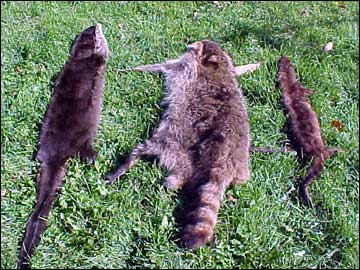
Otter, raccoon and mink pelts.
Part I of this article explored a few variations of the usual case skinned fur bearing animals. An otter pelt was the typical case skin with the feet cut off the pelt at each ankle, and the main opening made from one leg to the other. The second pelt was a raccoon, with usual cut on the rear legs, but all the paws and claw were left intact. The last pelt, and the main point of the article, is a roadkill mink, skinned by making the cut on the throat, instead of the rear legs, and once again leaving the paws and claws intact. The neck cut skinning was in response to the story The Clan of the Cave Bear, and the description of Ayala and Isa's medicine bag. I described my "Huh? How does that work?" moment when I read the description of an otter skin medicine bag worn at the waist. The medicine bag is described as an otter skin made with only a single cut at the neck.

The neanderthal character of Isa is described at four and a half feet tall. This modern girl is four and a half feet tall tall, wearing the mink pelt in the same fashion as the Neanderthal medicine bag. The mink tail clears the ground by a few inches.
Here she is with the otter pelt, once again worn at the waist. She has to hold the one and a half foot long tail to keep it from dragging on the ground.

Smoking the mink was a real challenge. This was the first attempt, channeling the smoke into the neck opening. I am not really sure why this did not work, but the result was very uneven color to the flesh side of the pelt.
Here is the smoking setup that worked. The smoke is funneled into the small opening under the tail. The white thing is a paper funnel attached to a blue denim chimney.

Here is a close-up of the raccoon's front paw. The paws are a bit stiff and wrinkly.
Is there any practical reason for keeping the paw/claws on a pelt? Any claws left on clothing would probably be scratch hazard to the wearer. Paws left on a container pelt would make more sense. They are a lot more work, but esthetics might make it worth the effort.
This was a great project to challenge my tanning skills. The cut across the throat, Neanderthal medicine bag turned out to be a more difficult challenge than I expected. It was a lot of extra work with marginal results. The tail had to be opened anyway, so the whole idea of a single opening at the neck was compromised. Skinning and drying the pelt was more difficult than usual. The feet and lower legs had to be reworked after the rest of the pelt was softened. Even smoking the pelt was difficult. Intact paws and claws are quite a challenge too, but look so nice. Someday I will tan another pelt with claws.

REFERENCES
Auel, Jean M
n.d.
The Clan of the Cave Bear, p 11-12 & 233
E-mail your comments to "Bill Scherer" at scherer_william@hotmail.com
Bill Scherer resides in Minnesota.
We hope the information on the PrimitiveWays website is both instructional and enjoyable. Understand that no warranty or guarantee is included. We expect adults to act responsibly and children to be supervised by a responsible adult. If you use the information on this site to create your own projects or if you try techniques described on PrimitiveWays, behave in accordance with applicable laws, and think about the sustainability of natural resources. Using tools or techniques described on PrimitiveWays can be dangerous with exposure to heavy, sharp or pointed objects, fire, stone tools and hazards present in outdoor settings. Without proper care and caution, or if done incorrectly, there is a risk of property damage, personal injury or even death. So, be advised: Anyone using any information provided on the PrimitiveWays website assumes responsibility for using proper care and caution to protect property, the life, health and safety of himself or herself and all others. He or she expressly assumes all risk of harm or damage to all persons or property proximately caused by the use of this information.
© PrimitiveWays 2013